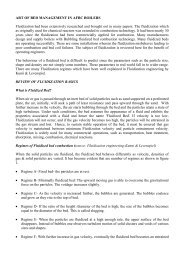Create successful ePaper yourself
Turn your PDF publications into a flip-book with our unique Google optimized e-Paper software.
have a shorter duration to perform flow measurements.<br />
<strong>CFD</strong> allows observation of flow properties without disturb<strong>in</strong>g the flow itself, which is not always<br />
possible with conventional measur<strong>in</strong>g <strong>in</strong>struments.<br />
<strong>CFD</strong> allows observation of flow properties at locations which may not be accessible to (or<br />
harmful for) measur<strong>in</strong>g <strong>in</strong>struments. For example, <strong>in</strong>side a combustion chamber, or between<br />
turb<strong>in</strong>e blades.<br />
<strong>CFD</strong> can be used as a qualitative tool for discard<strong>in</strong>g (or narrow<strong>in</strong>g down the choices between),<br />
various designs. Designers and analysts can study prototypes numerically, and then test by<br />
experimentation only those which show promise.<br />
Ducts <strong>in</strong> boiler system- Scope for application<br />
In the case of Industrial boilers / captive power plants, the boiler capacities are not standardised due<br />
to various reasons such as plant layout, plant capacity requirement, fuel comb<strong>in</strong>ations to be used. The<br />
duct layouts are eng<strong>in</strong>eered every time. Honestly the boiler design eng<strong>in</strong>eers <strong>in</strong> some companies do<br />
not have practical exposures. They tend to copy / make draw<strong>in</strong>gs based on the reference projects.<br />
The designs <strong>in</strong> most of the case are thus not optimised. There are many <strong>in</strong>stances where the duct<br />
layout is so awkward, that the fans are not able to handle the additional resistances encountered. An<br />
expert eng<strong>in</strong>eer should be able to identify the defects <strong>in</strong> design.<br />
<strong>CFD</strong> comes handy to visualise the flow pattern and to decide on the corrections to be carried out.<br />
We present some cases where we made use of <strong>CFD</strong> program to expla<strong>in</strong> the picture now and the<br />
picture when the suggested modification is implemented.<br />
<strong>Case</strong> 1 – Wrong fan <strong>in</strong>let duct layout<br />
This is a case of a CFBC boiler where<strong>in</strong> the PA fan and SA fan <strong>in</strong>let duct layouts are not proper. See<br />
picture by the side. The fan <strong>in</strong>let duct<br />
layout is such that the air is imparted with a<br />
pre-swirl which is not favourable to that of<br />
the impeller and volute cas<strong>in</strong>g.<br />
Flow dividers can be added to modify the<br />
flow pattern so that the direction of swirl is<br />
reversed. A top <strong>in</strong>let duct is generally the<br />
right way.<br />
The modell<strong>in</strong>g was done us<strong>in</strong>g Catia<br />
software. The mesh<strong>in</strong>g was generated us<strong>in</strong>g<br />
gambit. The <strong>analysis</strong> was done us<strong>in</strong>g <strong>CFD</strong><br />
software. Picture 2 is the present duct<br />
configuration and the picture 3 is the flow<br />
vectors. We f<strong>in</strong>alised flow dividers as<br />
Picture 1: PA fan suction duct

















